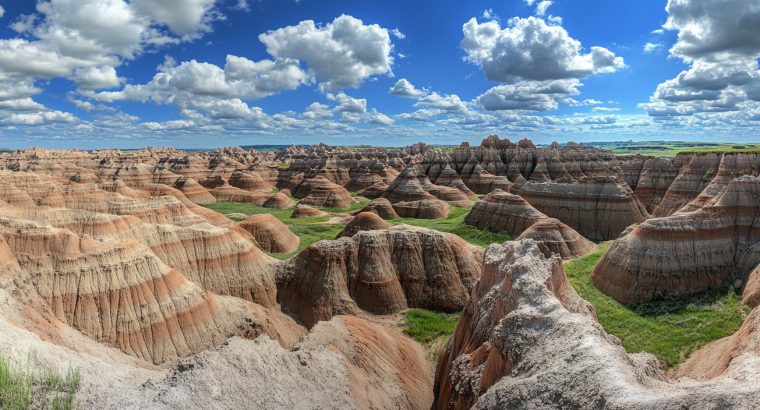Badlands National Park – 배들랜즈 국립공원
Exploring Badlands National Park – 배들랜즈 국립공원: A Comprehensive Guide
Badlands National Park—known in Korean as 배들랜즈 국립공원—is one of the hidden gems of the American wilderness. Encompassing a striking landscape of eroded buttes, pinnacles, and spires, intertwined with the largest undisturbed mixed-grass prairie in the United States, this park is a captivating destination for adventurers and nature lovers alike. This guide will take you through the wonders of Badlands National Park, providing key insights into its geography, history, wildlife, and visitor tips.
A Journey Through the Landscape
Geography and Geology
Located in southwestern South Dakota, Badlands National Park covers over 244,000 acres. The area is renowned for its layered rock formations, which provide a visual record of several million years of history. These formations are composed mainly of sedimentary rock, deposited by ancient seas, rivers, and winds. Over time, erosion from wind and rain has sculpted the striking features seen today, making the park a fascinating study of geology and natural history.
The Formation of the Badlands
The formation of Badlands National Park was a process spanning nearly 75 million years. During the late Cretaceous period, the area was submerged under a shallow sea. As the sea receded, a series of climate shifts and erosion carved the dramatic landscapes we visit today. The layers within the rocks hold a treasure trove of fossils, including remnants of early mammals like the saber-toothed cat, horses, and ancient rhinoceroses.
Historical Significance
Native American Tribes
The area now known as Badlands National Park has long been important to Native American tribes, particularly the Lakota people. Known for its harsh beauty, the Badlands held spiritual significance and served as a hunting ground. The Lakota referred to the region as “Mako Sica,” meaning “land bad,” reflective of the challenging terrain and extreme weather conditions.
Early Exploration and Park Establishment
The area’s stark beauty and unique geological formations attracted explorers and scientists in the late 19th and early 20th centuries. Badlands National Monument was established in 1939, later becoming a national park in 1978. The park’s establishment aimed to preserve its unique geology, paleontological resources, and ecosystems while offering educational and recreational opportunities to visitors.
Wildlife and Ecosystems
Flora and Fauna
Despite its seemingly barren landscape, Badlands National Park is teeming with life. The mixed-grass prairie hosts a variety of wildlife, including bison, bighorn sheep, pronghorn antelope, and the elusive black-footed ferret, one of the most endangered mammals in North America. Birdwatchers can spot species like the golden eagle, prairie falcon, and burrowing owl.
The park’s plant life is equally diverse, with grasses like western wheatgrass and little bluestem coexisting alongside hardy wildflowers such as prairie coneflower and scarlet globe mallow. These resilient plants have adapted to the challenging conditions, creating a vibrant ecosystem that supports a complex food web.
Activities and Attractions
Scenic Drives and Overlooks
One of the most popular ways to experience Badlands National Park is by taking a scenic drive. The Badlands Loop Road, a 39-mile stretch, offers breathtaking vistas and several pullouts with interpretive signage. Be sure to stop at the Big Badlands Overlook, Pinnacles Overlook, and Yellow Mounds Overlook for some of the park’s most iconic views.
Hiking Trails
For those willing to explore on foot, the park offers several hiking trails ranging from easy to challenging. Here are some of the must-try hikes:
- Door Trail: A relatively short, one-mile trail that leads to a spectacular view of the Badlands formations.
- Notch Trail: Known for its adventurous ladder climb, Notch Trail offers dazzling views of the White River Valley.
- Castle Trail: At 10 miles round-trip, this is the longest trail in the park, showcasing diverse terrains and panoramic views.
Fossil Hunting
The Badlands are an open book when it comes to paleontology. Visitors can seek out fossils along the trails. While collecting fossils is prohibited to preserve the park’s resources, you can join guided programs to learn about the history written in these ancient stones.
Night Sky Viewing
The remoteness of Badlands National Park makes it an ideal spot for stargazing. On a clear night, the sky comes alive with countless stars, constellations, and the occasional meteor shower. The park often hosts night sky programs, offering telescopes and guidance on navigating the celestial wonders.
Tips for Visiting Badlands National Park
Best Time to Visit
The park is open year-round, but the best time to visit is late spring and early fall when temperatures are mild, and the weather is most pleasant. Summer can be very hot, with temperatures often exceeding 100°F (38°C), while winter can bring snow and icy conditions.
Park Facilities
The Ben Reifel Visitor Center is a great starting point for first-time visitors. It offers educational exhibits, a theater presentation about the park’s history, and a bookstore. Cedar Pass Lodge provides dining and accommodation options, while the adjacent campgrounds offer sites for tents and RVs.
Safety and Regulations
- Wildlife Safety: Always maintain a safe distance from wildlife. Bison, in particular, may seem docile but can be unpredictable if approached.
- Weather Preparedness: Sudden changes in weather are common. Bring layers, sunscreen, and sufficient water, especially for hikes.
- Leave No Trace: Follow the “Leave No Trace” principles by staying on marked trails, carrying out all trash, and respecting the park’s natural and cultural resources.
Conclusion
Badlands National Park—배들랜즈 국립공원—is an extraordinary destination that offers more than just striking landscapes; it’s a place of profound natural history and cultural heritage. With its endless vistas, rich ecosystems, and outdoor activities, this park is well worth a visit. Whether you’re drawn in by the prospect of stunning photography, wildlife observation, or simply the chance to disconnect amidst nature’s beauty, the Badlands will leave you with memories to cherish for a lifetime.

